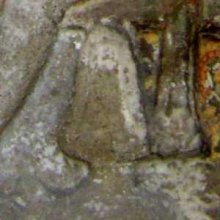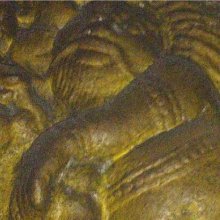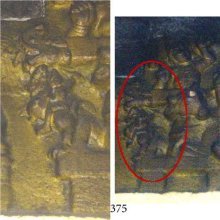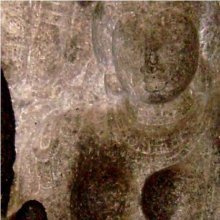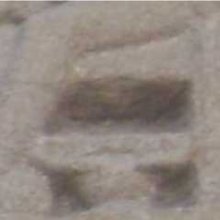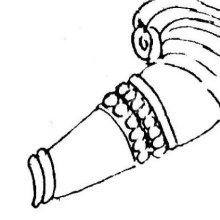Somaskanda, Somāskanda: 2 definitions
Introduction:
Somaskanda means something in Hinduism, Sanskrit, the history of ancient India. If you want to know the exact meaning, history, etymology or English translation of this term then check out the descriptions on this page. Add your comment or reference to a book if you want to contribute to this summary article.
Images (photo gallery)
(+7 more images available)
In Hinduism
Shilpashastra (iconography)
Source: Shodhganga: Iconographical representations of Śiva (shilpa)1) Somāskanda (सोमास्कन्द) or Somāskandamūrti refers to one of the twenty-eighth forms (mūrti) of Śiva mentioned in the Vātulāgama: twenty-eighth among the Siddhāntaśaivāgama. The forms of Śiva (e.g., Somāskanda) are established through a process known as Sādākhya, described as a five-fold process of creation. Somāskanda is also listed among the eight forms (mūrti) of Śiva mentioned in the Rauravāgama: the sixteenth among the Siddhāntaśaivāgamas. Somāskanda is also listed among the eighteen forms (mūrti) of Śiva mentioned in the Śilparatna (twenty-second adhyāya): a technical treatise by Śrīkumāra on Śilpaśāstra.
2) Somāskanda is the name of a deity found depicted in the Subramanya Swamy Temple (or Subramaṇya Svāmi Temple) in Thiruparankundram or Parankundram (Paraṅkuṉṟam), representing a sacred place for the worship of Murugan.—Śiva is seated in sukhāsana pose with the left leg folded and is represented with four hands. The upper two hands are in kartarīmukha-hasta, holding the aṅkuśa in the right and the deer in the left. The lower right hand is in patāka-hasta and the lower left hand is in kapittha. Pārvatī is found seated in sukhāsana pose with the right leg folded and the left leg hanging loose. She is represented with two hands in kapittha-hasta. Murukan is found at the centre in araimandi pose, that is, kṣipta (half sitting with knees bent and turned apart) or āyata maṇḍala. When described in iconographic terms, he is said to stand in vaitastika-sthānaka with knees slightly bent. Both the hands are found in kartarīmukha holding śakti in the right and vajra in the left.

Shilpashastra (शिल्पशास्त्र, śilpaśāstra) represents the ancient Indian science (shastra) of creative arts (shilpa) such as sculpture, iconography and painting. Closely related to Vastushastra (architecture), they often share the same literature.
India history and geography
Source: Cologne Digital Sanskrit Dictionaries: Indian Epigraphical GlossarySomaskanda.—South Indian representation of Śiva along with Umā and Skanda. Note: somaskanda is defined in the “Indian epigraphical glossary” as it can be found on ancient inscriptions commonly written in Sanskrit, Prakrit or Dravidian languages.

The history of India traces the identification of countries, villages, towns and other regions of India, as well as mythology, zoology, royal dynasties, rulers, tribes, local festivities and traditions and regional languages. Ancient India enjoyed religious freedom and encourages the path of Dharma, a concept common to Buddhism, Hinduism, and Jainism.
See also (Relevant definitions)
Starts with: Somaskandamurti, Somaskandasthapana.
Full-text: Somaskandamurti, Balasvami, Ayata, Prerita, Mahesha.
Relevant text
Search found 11 books and stories containing Somaskanda, Somāskanda; (plurals include: Somaskandas, Somāskandas). You can also click to the full overview containing English textual excerpts. Below are direct links for the most relevant articles:
Cosmetics, Costumes and Ornaments in Ancient India (by Remadevi. O.)
2.13. Costumes of Deities < [Chapter 2 - Costumes]
2.5. Various other Hand Ornaments < [Chapter 3 - Ornaments]
2.1. Various other Head Ornaments < [Chapter 3 - Ornaments]
Kashyapa Shilpa-shastra (study) (by K. Vidyuta)
7. Favourable Directions for Installing the Śiva Mūrtis < [Chapter 3 - Prākāra Lakṣaṇa]
Pallava period (Social and Cultural History) (by S. Krishnamurthy)
Head-dress of Children < [Chapter 4 - Material Culture of the People]
Leg Ornaments < [Chapter 4 - Material Culture of the People]
Shoulder Ornaments < [Chapter 4 - Material Culture of the People]
Early Chola Temples (by S. R. Balasubrahmanyam)
Bronze, group 1: Late Pallava and Early Chola—Age of Vijayalaya (a.d. 785-871) < [Chapter XI - Sculpture]
Kailasanathar Temple < [Chapter XIV - Conclusion]
Part II, Bronzes < [Chapter XI - Sculpture]
Middle Chola Temples (by S. R. Balasubrahmanyam)
Temples in Tirunedungalam < [Chapter II - Temples of Rajaraja I’s Time]
Temples in Tiruppainjili < [Aditya I]
Temples in Tirukkaravasal < [Chapter II - Temples of Rajaraja I’s Time]
Later Chola Temples (by S. R. Balasubrahmanyam)
Temples in Manimangalam < [Chapter XIX - Supplement]
Temples in Trisulam < [Chapter II - Temples of Kulottunga I’s Time]
Temples in Nidur < [Chapter II - Temples of Kulottunga I’s Time]
Related products
